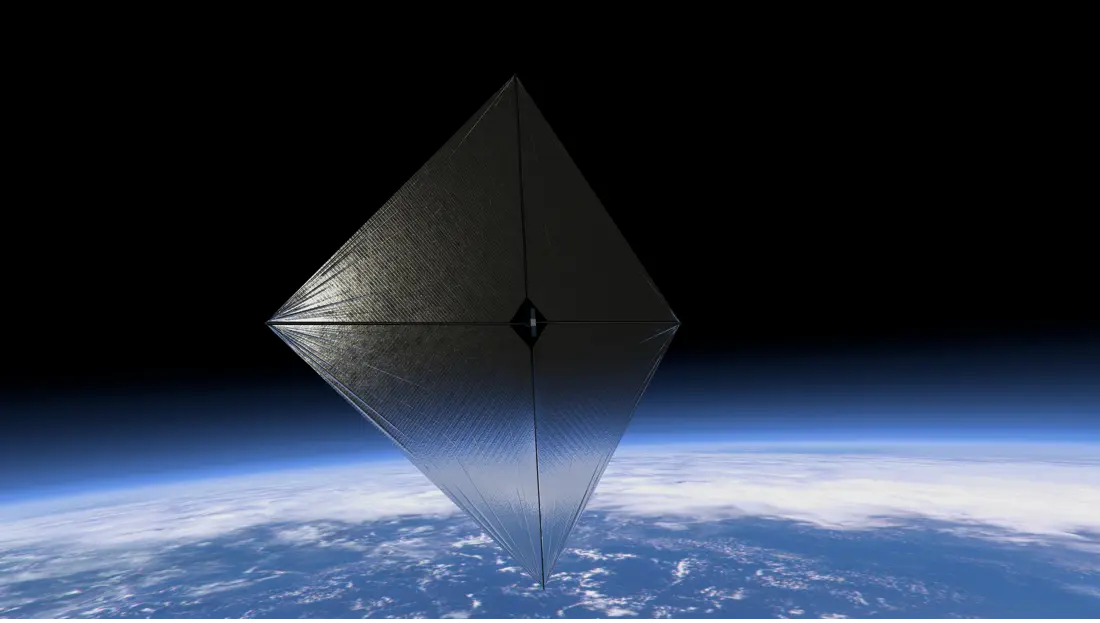NASA's solar sail successfully spreads its wings in space
NASA's solar sail successfully spreads its wings in space

Spacecraft data has confirmed successful deployment of the futuristic technology.

NASA's solar sail successfully spreads its wings in space

Spacecraft data has confirmed successful deployment of the futuristic technology.

Thankfully for us, the spacecraft that deployed the sail contains four cameras that can capture a panoramic view of both the reflective sail and the accompanying composite booms. The first of the high-resolution imagery is expected to be accessible on Wednesday, Sept. 4.
I can't wait.
Though photons don't have mass, they can force momentum when they hit an object — that's what a solar sail takes advantage of.
Sounds like a bug.
It’s a feature.
Either way, NASA is already exploiting it. I guess, next they’ll find a way to glitch through the very fabric of the universe to teleport to a distant galaxy without moving at all or even using any energy.
Must be a problem with floating point precision.
Infinite energy glitch
Yeah, why do masless particles have momentum? And please not because law X says so.
In short, even though photons have no mass, they still have momentum proportional to their energy, given by the formula p=E/c. Because photons have no mass, all of the momentum of a photon actually comes from its energy and frequency as described by the Planck-Einstein relation E=hf.
From here: https://profoundphysics.com/if-photons-have-no-mass-how-can-they-have-momentum/
Essentially, momentum is a function of energy, not mass. It's just that massive objects have way more momentum than massless ones.
Energy is mass
Witchcraft.
Radiation pressure does not have anything to do with mass-energy equivalence. 1), the energy for this process does not come from the conversion of electric energy into mass, and 2) having a momentum is not a property tied to massive particles. All electromagnetic waves carry momentum according to Maxwell's theory of electromagnetism, and its transfer is fully explained by his equations and results from the interaction of the EM wave with matter, i.e., absorption and reflection. Each such interaction will transfer momentum to the massive object. This is classical physics, you don't need any Einstein relativity to explain electromagnetic phenomena because his theories only become relevant for very massive bodies and their movement, and nuclear reactions.
This NASA video is pretty amazing. I was wondering how they did the booms and they are soft carbon fiber tubes rolled up on spools. I was imagining that you could simply spin the sail and use centrifugal force to expand it.
Maybe someone can answer me this: I've always wondered if a solar sail can only generate momentum away from the sun or if it can be angled to create momentum in other direction. Since the light is reflected and not absorbed, angling it e.g. 45° you change the "momentum" of the photons. That should also change the momentum impacted on the solar sail and spacecraft. Right?
Maybe someone can answer me this: I've always wondered if a solar sail can only generate momentum away from the sun or if it can be angled to create momentum in other direction.
Yeah, 100%. You can totally steer and control your orientation with a solar sail. This is one of the rare actually intuitive things when it comes to spaceflight. (with physics in space It seems like nothing actually works the way you'd expect it to, but this basically does)
We actually have some experience controlling orientation with "solar sails" too. I remember one example of a spacecraft which long after finishing its official mission was left to tumble out of control. Years later, some engineers were able to regain control, use the last of its propellant to counter its tumble and then keep it oriented correctly using only its solar panels as sails, light pressure was carefully controlled to keep the spacecraft oriented.
I could be mistaken, but I believe NASA used the same technique with light pressure to keep Kepler oriented properly as its reaction wheels each failed in sequence.
Ah thank you, never seen that mentioned. That makes it even more awesome for solar system exploration! The article mentioned expanding to much larger designs too.
PS: Now I wonder if assembling these solar sails with lightweight girders in orbit on a space station would be worth it. The spooling mechanism is awesome but if you could just send it up dis-assembled and assemble it in space they could probably be more efficient.
Haven't heard about the NASA design yet, but JAXA's 2010 IKAROS used "Eighty blocks of LCD panels are embedded in the sail, whose reflectance can be adjusted for attitude contro ".
That's such a badass design, I love it.
A variable thrust and thrust vectoring propulsion system with no moving parts. I doubt that's ever been done before...
I wonder how long it will take to get to Cardassia
I hope it can be sent somewhere neat once they are done testing. But I assume it’s not configured for long range communication.
It would be cool if it could be sent, slowly, to a “nearby” body.
Iirc, solar sail designs like this can actually go stupid fast when properly propelled by something like a laser array.
What's fun about these is that the mass of the actual vehicle can be much smaller if it doesn't need to carry rocketry and fuel on board. So even though they'll never compete with rockets for power (energy used over a specific length of time), starting at a lighter weight and never running out of fuel means that these systems could theoretically exceed the top speeds (relative to the earth) of our fastest rockets, given enough time.
Ramiel?
So hot right now!
First photo looks rather unspectacular: https://www.space.com/nasa-solar-sail-space-photo
NASA also has a "spot the diamond in the sky" challenge haha: https://www.space.com/nasa-solar-sail-space-photo
Here's a picture of it while it's still in the shop. https://inspenet.com/en/noticias/nasa-tests-solar-sail-in-solar-in-orbit/